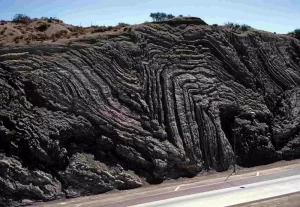Table of Contents
In this article, we will discuss folding vs faulting.
An earthquake may be defined as the sudden shock of the earth that emits the energy in the earth’s lithosphere causing the formation of seismic waves.
The earthquake can be caused due to volcanic eruption, moving of tectonic plates, formation of the cave in a small area, or due to explosions. It is determined with the help of a seismograph by seismometers and is measured on the Richter Magnitude Scale.
1. Fault
A fault may be defined as a crack or region of the crack between two blocks of rock. Faults permit the blocks to displace relative to each other. This movement may occur quickly, in the form of an earthquake, or may occur steadily, in the form of creep. Faults may vary in span from millimeters to thousands of kilometers.

2. Fold
A fold may be defined as a heap of initially planar surfaces, such as sedimentary strata, that are bent or curved during lasting deformation. Folds in rocks range in size from microscopic crinkles to mountain-sized folds. They happen as single isolated folds or in periodic sets known as fold trains.

3. Folding Vs Faulting
The difference between folding and faulting are as follows:
| Folding | Faulting |
| Folds are bends in the rocks that occur due to the action of compressional forces. | Faults are observed due to the action of tensional forces across which movements of rocks take place. |
| Folding happens when compressional force is acted on rocks that are ductile or flexible in nature. | Faults happen when forces acting in opposite directions result in tension and as a result, rocks produce cracks in the fissure. |
| Rocks that are situated deep within the crust and therefore are under high pressure are ductile and particularly susceptible to folding without breaking. | Rock layers that are close to the surface and not under high confining pressure are too rigid to bend into folds, but if the tectonic plates are too big rocks split. |
| Folds form under a varied state of stress, pore pressure, and temperature gradient, as evidenced by their existence in soft sediments, the full spectrum of metamorphic rocks. | With normal dip-slip faults, the rock masses compress on each other vertically, and the rock displaces slightly downward. |
| Folds are majorly made by shortening previous layers, but may also be made as an outcome of movement on a non-planar fault | A fault plane is a plane that shows the crack surface of a fault. A fault trace or fault line is a place where the fault can be observed or mapped on the surface. |
| A fold surface observed perpendicular to its shortening direction can be split into hinge and limb portions, the limbs are the flanks of the fold and the hinge zone is where the limbs converge. | A fault zone is a cluster of parallel faults. However, the term is also used for the zone of crushed rock along a single fault. |
| Minor folds are observed in outcrop; major folds seldom are except in the more arid countries. Minor folds can, however, usually provide the key to the major folds they are linked to. | All faults have a noticeable thickness, prepared of deformed rock characteristic of the level in the crust where the faulting occurs, the rock types affected by the fault, and the presence and nature of any mineralizing fluids. |
| The folding outcome in the Himalayan Mountains, Alps, etc. | Faulting is an outcome of the evolution of blocked mountains and river valleys like the Narmada, and Tapi. |
5. Types of Fault
The types of fault are as follows:
a. Normal Fault
Normal, or Dip-slip, faults may be defined as the inclined cracks where the blocks have majorly moved vertically. The hanging wall moves downward.

b. Reverse Fault
A reverse fault is also known as a thrust fault if the dip of the fault plane is tiny. In a reverse fault, the earth on one side passes up and over the other side.

c. Strike-Slip Fault
The strike-slip fault is also known as a transcurrent fault, wrench fault, or lateral fault. Strike-Slip faults are vertical or nearly vertical cracks where the blocks have majorly moved horizontally.

| Read Also: Biggest Tsunamis in History |

